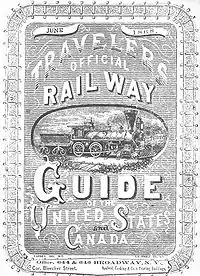Official Guide of the Railways
The Official Guide of the Railways, now known as the Official Railway Guide, was originally produced by National Railway Publication Company of New York City, beginning in 1868. The modern Official Railway Guide provides routing and shipping information for freight on United States railroads and is now published by the RailResource division of JOC (formerly Journal of Commerce).
 The modern Official Railway Guide | |
| Categories | Rail transport |
|---|---|
| Frequency | Quarterly |
| First issue | June 1868 |
| Company | The Pocket List of Railroad Officials (IHS Markit) |
| Country | USA |
| Language | English |
| Website | www |
| ISSN | 0190-6704 |
History

.jpg.webp)
In the post-Civil War era of the late 1860s, as the transcontinental railroad pushed westward across the prairies, the burgeoning growth of railroad passenger traffic created the need for accurate train schedule information. On October 2, 1866, the National Association of General Passenger and Ticket Agents passed a resolution calling for a "railway guide" to be published, for use as a reference by all association members.[1] The result was the monthly publication of the Travelers Official Railway Guide of the United States, Mexico and Canada, beginning with a 200-page first edition in June 1868. Eventually the Official Guide would list all of the passenger train schedules of railroads in the United States, Canada, Mexico and Central America. At the peak of rail passenger service in the 1920s, "The Guide", as it was commonly known in the industry, exceeded 1,500 pages and was widely used by railroad personnel, travel agents, and corporate travel departments. With the advent of passenger airlines the Official Guide included schedules for major US airlines. The Official Guide was the primary reference used by ticket agents for all railroads in the U.S. and Canada, and for international rail travel to Mexico. The Guide was especially useful for constructing connections among the many railroads of the time.
The Official Guide also included some high priority freight schedules, system maps, listing of company officers, an index of all railroad stations, industry news briefs and personnel changes, rosters of key railroad officials, and new passenger train announcements, along with steamship schedules.
Other related publications produced by National Railway Publication Company and its affiliates included the Pocket List of Railroad Officials and freight equipment listings.
With the decline of long-distance passenger service in the U.S. during the 1950s–1960s and the eventual demise of passenger service by most individual railroads at the inception of Amtrak on May 1, 1971, the need for a monthly rail passenger Official Guide diminished considerably. In the years after Amtrak was established the Official Guide was split into separate freight and passenger editions.
Currently
Some of the publications by the National Railway Publishing Company were eventually acquired by UBM Global Trade (then known as Commonwealth Business Media), which in turn became a division of United Business Media.[2] United Business Media, a United Kingdom-based firm, provides business information services principally to the technology, healthcare, media, automotive, and financial services industries. With the resurgence of rail freight in the U.S. since the 1990s, the quarterly Official Railway Guide is used by transportation and logistics managers for routing and shipping information. UBM sold the majority of its data business to Electra Partners in 2013, who formed AXIO Data Group, which was then sold to IHS in 2014[3]
References
- 100th Anniversary Edition, The Official Railway Guide. National Railway Publication Company. June 1968.
- "UBM GT's Timeline of Significant Events UBM Global Trade". United Business Media. Archived from the original on 2009-01-25. Retrieved 2008-01-27.
- UBM data service sale disappoints market